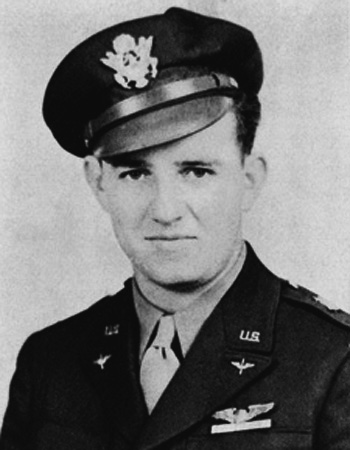Charlie Brown was born on October 24, 1922, in West Virginia. He enlisted in the U.S. Army on October 19, 1939, and served in the Signal Corps before entering the Aviation Cadet Program of the U.S. Army Air Forces on July 16, 1942. Brown was commissioned a 2d Lt and awarded his pilot wings on April 29, 1943, and then was trained as a B-17 Flying Fortress pilot. He was then assigned to the 527th Bomb Squadron of the 379th Bomb Group in England, where he flew 29 combat missions before returning to the United States. Lt Brown left active duty and entered the Air Force Reserve on December 2, 1945, and returned to active duty from October 15, 1946, to October 9, 1947. He then served in the reserves until going back on active duty beginning October 29, 1949. Brown was then trained as a Special Agent with the Air Force Office of Special Investigations, serving at Wright-Patterson AFB, Ohio, from October 1949 to December 1951, and with U.S. Air Forces in Europe in Wiesbaden, West Germany, until April 1953. He served in London, England, from April 1953 to September 1954, and then received an Air Force Institute of Technology assignment to George Washington University from September 1954 to August 1955. His next assignment was as an Intelligence Officer with Headquarters Tactical Air Command at Langley AFB, Virginia, from August 1955 to August 1959, and he then attended Armed Forces Staff College at Norfolk, Virginia, from August 1959 to April 1960. Col Brown served as an Intelligence Liaison Exchange Officer with the Royal Air Force in London from April 1960 to August 1963, and he then served with the Defense Intelligence Agency until his retirement from the Air Force on June 30, 1965. After retiring from the Air Force, Charlie served as a Senior Foreign Service Officer with the Department of State in Southeast Asia from 1965 to 1971, and retired in 1972. He was later awarded the Air Force Cross for action during a bombing mission over Germany in December 1943. Charlie Brown died on November 24, 2008, and was buried at the Woodlawn Park Cemetery in Miami, Florida.
His Air Force Cross Citation reads:
The President of the United States of America, authorized by Title 10, Section 8742, U.S.C., awards the Air Force Cross to Second Lieutenant Charles L. Brown for extraordinary heroism in military operations against an armed enemy of the United States as a B-17 Pilot over Germany, 20 December 1943. On this date while attacking a heavily defended target over occupied Germany, Lieutenant Brown's aircraft sustained sever flak damage, including destruction of the Plexiglas nose, wing damage, and major damage to the number two and four engines. Lieutenant Brown provided invaluable instructions to the copilot and crew requiring the number two engine to be shut down. He then expertly managed to keep the number four engine producing partial power. This action enabled his crew to complete the improbable bombing run and bomb delivery on this important strategic target. Immediately upon leaving the target, sever multiple engine damage prevented maintaining their position in the formation. During this extreme duress, the demonstrated airmanship displayed by Lieutenant Brown could only be described as crucially pivotal to the aircraft's survival and displayed by only more seasoned and experienced aviators during the War. His violent, evasive tactics to counter the multiple enemy efforts to destroy their airplane directly contributed to his crew and his aircraft's survival. Alone and outnumbered, the aircraft was mercilessly attacked by the enemy in which crew difficulties were compounded when discovered only three defensive guns were operational, the others frozen in the -75 degree Fahrenheit temperatures. The results of this brief, but devastating aerial battle was one crew member dead; another critically wounded that would require amputation of his leg; serious damage of the third engine; the complete destruction of the aircraft's left elevator and stabilizer; the inoperability of the bomber's oxygen and communications systems; and the complete shredding of the rudder by enemy fire that produced a death roll of the plane as it spiraled helplessly out of control causing the entire crew to temporarily lose consciousness. Miraculously, prior to ground impact, Lieutenant Brown and the copilot regained consciousness and managed to regain full flight control by pulling the heavily damaged aircraft out of its nose-dive. Although managing to recover this aircraft from certain doom, the crew's plight was further complicated when a lone German fighter witnessed the maneuver, now attempted to force the crippled aircraft to land. Displaying coolness, courage and airmanship of more senior pilots, he boldly rejected the enemy fighter's attempts at a forced landing and directed the struggling aircraft to the North Sea. While attempting this improbable, treacherous return to home station, Lieutenant Brown's command and control was instrumental to the remaining crew's survival. While in the cockpit, he provided the essential engine control, fuel management, and piloting skills necessary to the cockpit team during their hazardous, yet miraculous return of the aircraft's perilous crossing of the North Sea back to home station in England. Through his extraordinary heroism, superb airmanship, and aggressiveness in the face of the enemy, Lieutenant Brown reflected the highest credit upon himself and the United States Army Air Corps.
|



